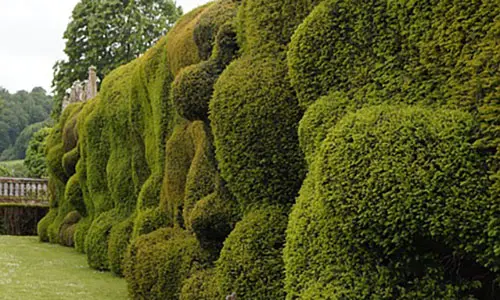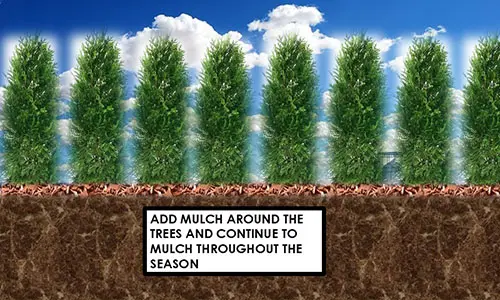An open yard is an open invitation. Regardless of the situation, an open yard provides easy access to all doors, windows, and just about anything you keep, store shelter around your house and yard. Here’s how to become invisible wherever you live.
A fence is an easy way to close off any yard. Prices vary and heights average about 6 feet. You can have them professionally installed or do it yourself.
But there’s another way to make your home invisible that goes beyond the 6-foot fence.
The Tall Shrubbery Advantage
There’s an entire category of tall shrubs that grow both tall and thick that many people have used for centuries to block off their property and make it unseen to passersby.
In some instances, people have planted thorn bushes like wild blackberries or other types of thorny hedges. These not only obscure the visibility of a home but few people will be able to walk or crawl their way through it.
Here’s a short list of thorn bushes you can use as a barrier:
- Wild blackberry
- Black raspberry
- Red raspberry
- Wild roses
The only disadvantage with thorny bushes is that they don’t tend to grow taller than 6 feet; they often require a trellis or other type of support and are typically deciduous plants which means they will lose their leaves in the fall.
Without leaves, you lose the privacy and the ability to mask or obscure your home. The thorns are still there, but no leaves until spring.

Think Evergreen
There’s an option that both grows tall and thick to not only obscure your home but also keep people from entering. Better yet, they all fall in the class of bushes and trees defined as evergreen.
You also want to think about shrubbery or trees that grow fast. It won’t happen in a year but at least you won’t have to wait decades to get the security you’re hoping for. Here’s a good list of trees and shrubs to plant to make your home invisible:
Arborvitae (Thuja)
This is probably the most popular and frequently used evergreen tree for privacy screening and security. There are numerous varieties with some growing up to 40 feet tall.
Thuja is a variety most often used because the branches intertwine as the trees grow, and they form in impenetrable wall when pruned and trimmed.
Other possibilities include:
- Norway Spruce
- Arborvitae
- Leyland Cypress
- Emerald Green Arborvitae
- Hicks Yew
- Cherry Laurel
- Moonglow Juniper

Planning and Planting to Obscure Your Home
How far you choose to obscure or block your home from traffic or passersby depends a lot on your location and the areas you want to protect or block from view.
A simple way to start is with a drawing of your home and property and determining where you will plant for security or privacy. Once you have generally identified the key areas you need to determine the best shrubs or trees to plant for those areas.
Ideally, you’ll want hardy, evergreen varieties that grow together well into a thick hedge to both block the view and prevent entry. It’s also important to pay attention to the mature height to meet your needs and look for the fast-growing varieties if you want things to happen fast.
Once you’ve identified which varieties you need to plant and how many, it’s time to start digging.
Here are some good ways to plant your privacy hedge to get all of the shrubs and trees off to a good start.
Dig Deep
The quality of your soil will have a lot to do with the tree or shrubs’ future health so dig deep and wide so you can enrich the soil around the root ball.
The hole you dig should at least be twice the size and height of the root ball. If you have particularly challenging soil like clay or sand, dig deeper.

Enrich the Soil
You’re going to be adding topsoil to the bottom of the hole as a foundation for root growth.


You should also pay attention to the depth. You want the top of the soil to just meet the top of the root ball. Don’t bury it too deep, especially up the trunk or branches.

This is probably the most important step. You want to surround the root ball with a loamy mix of equal parts peat, compost, and topsoil. This will get the plant off to the best start.
Water, Water, Water
A newly planted tree or shrub always struggles during its first year. The roots are trying to grow and if there’s a canvas wrapping around the root ball remember to cut it apart at the top and sides.
Get those ropes off and let the canvas decompose in the soil, but to activate any decomposition you need water.
Flood the hole after your tree or shrub is planted and the soil is topped around it. Let the water soak in and flood it again on the day you planted it. The next day, the flood is again and continues to water at least twice a day for the first week.

Chemical Feeding?
In addition to enriching the soil and mulching you can use chemical fertilizers to boost and accelerate growth. There are root feeders that you can plunge into the ground that allows you to use a garden hose and some fertilizer cartridges. Read the directions carefully or you might overfeed and harm the plant.
There are also fertilizer spikes you can pound into the ground. Space them properly between your plantings.
Creating the Hedge
This is simple but it requires a good amount of digging and planting, but what you want to do is imagine what your privacy hedge will look like when mature.
Plant each tree or shrub at the recommended distance for that variety, and continue planting based on your plan.

Mulch, Mulch, Mulch
A top dressing of mulch will help to hold in moisture and as it decomposes it will continue to enrich the soil. Mulch regularly especially in the first and second years.

It’s Going to Take Time
It’s going to take a few seasons for your trees or shrubs to mature. If you plant them deep, enrich the soil, and keep them well-watered, they’ll grow quickly.
If for some reason you don’t think they’ll grow fast enough -well, maybe you need to start thinking about that fence instead.
Items You Need to EMP-Proof Before It’s Too Late
How to Looter-Proof Your Property (Video)
What The Pioneers Did To Survive Harsh Winters
Livestock Animals You Should Start Raising For The Upcoming Economic Crisis



















